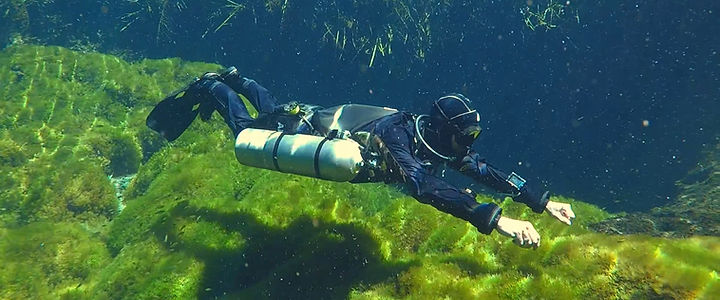
SIDEMOUNT DIVER
Foundational sidemount course
In a Nutshell
The TDI Sidemount Diver Course with CDT Mexico is designed for divers seeking a streamlined, redundant gas setup with a solid technical foundation.
It teaches configuration, management, and optimization of sidemount equipment for technical and cave diving. Students gain proficiency in buoyancy control, advanced propulsion, gas planning, regulator handling, and efficient equipment donning/doffing.
The course includes water entry/exit sequences and problem-solving in challenging conditions, with emphasis on team communication, situational awareness, and managing failures while maintaining control.
Mastering these skills ensures a safe, efficient transition to technical or cave diving in sidemount configuration, preparing divers for advanced exploration.
Minimum course duration: 4 days.
Who This Course Is For
This course is designed for certified divers who want to:
-
Learn sidemount correctly from the start
-
Improve comfort, balance, and control in the water
-
Prepare for cave or technical diving using sidemount
-
Refine or rebuild sidemount fundamentals that may have been learned informally
This is a skills-first course. Configuration details matter, and adjustments are continuous throughout training.
Prerequisites
-
Minimum age: 18
-
Open Water Diver (or equivalent)
-
TDI Nitrox (Nitrox 32 used as standard gas)
-
Minimum 25 logged dives
Skills & Challenges Ahead
Sidemount introduces new challenges compared to single-tank or manifolded backmount diving:
-
Independent cylinders and regulators
-
Active gas management
-
Equipment balance and streamlining
-
Increased task loading during problem-solving
Training emphasizes control, awareness, and consistency rather than speed or shortcuts.
Training Content (overview)
In-water training includes:
-
Gas management, awareness, and maintaining redundancy
-
Regulator switching techniques (two hands, one hand, in low visibility)
-
Hand and light communication
-
Fundamental skills: breathing, buoyancy, trim, propulsion, and positioning
-
Advanced propulsion: modified frog kick, modified flutter kick, reverse kick, and helicopter turn
-
Problem-solving scenarios: mask replacement, cylinder rigging, or bungee failures
-
Managing leaks and free-flows (valves, first and second stages, LPI hose, etc.)
-
Lift bag deployment
Land-based training covers:
-
Equipment configuration and set-up
-
Pre-dive checks and team dynamics
-
Donning/doffing sequences
-
Gas switch simulations
-
Communication drills
-
Thorough briefings and debriefings for every exercise
Academic presentations explore:
-
Awareness and mindset in sidemount diving
-
Gas planning strategies: rule of thirds, conservatism, and gas matching
-
Maintaining redundancy and regulator switch protocols
-
Dive planning, potential failures, and countermeasures
-
Emergency and safety procedures
-
Psychological and physiological considerations
-
Stress recognition, management, and maintaining control
Course Combinations
Minimum durations shown
Sidemount
4 days
Nitrox + Sidemount
5 days (1 "dry" day)
Get Ready
Training is not about collecting a card.
It’s about earning real autonomy, safety, and confidence.
The objective: divers who can plan and execute dives independently.




